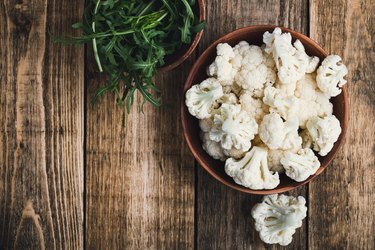
With people looking to lower carb intake, the lowly cauliflower has seen a rise in popularity. From pizza crusts and rice to a stand-in for chicken wings, there are endless ways to use this cruciferous vegetable.
Blanching is the best method for freezing cauliflower, but it's not the only way.
Video of the Day
Video of the Day
Freezing Cauliflower Without Blanching
Blanching is the most common and recommended way to prepare vegetables for freezing. Submerging fresh vegetables in boiling water, then quickly cooling them in an ice bath halts the action of enzymes in the food that can degrade freshness, preserving the color and texture of frozen veggies.
Blanching also helps to clean and destroy microorganisms on the produce before cold storage, and it can protect against the loss of certain vitamins during freezing, according to the University of Wisconsin.
Inarguably, blanching is the best method for freezing cauliflower, but it's not the only method. If you don't want to, or can't, blanch your cauliflower, you can still freeze it, but the finished result won't be quite as good.
First things first: Make sure you have proper storage containers. Plastic containers made for freezing or heavy duty freezer bags will protect delicate cauliflower against freezer burn.
Remove the leaves and stem from the cauliflower head, and chop into florets. Rinse the florets well under running water, then place in a colander to drain thoroughly. Next, lay them on a kitchen towel and allow them to dry. Removing as much moisture as possible will improve the quality of the frozen florets.
Put the florets in a plastic container or freezer bag in a single layer. Lay the bag flat in the freezer. You can also arrange the florets in a single layer on a cookie sheet lined with parchment paper, put it in the freezer until the florets are completely frozen, then pack them into containers. Freezing them this way means they won't freeze together, so you can take out only the amount you need and put the rest back in the freezer.
You can also freeze cauliflower rice. Just place the rice in the bag or container, remove as much air as you can and pop it in the freezer.
Tip
There are so many ways to use frozen cauliflower, from spicy roasted cauliflower to cauliflower bread. Try freezing fresh broccoli and cauliflower together, along with carrots and edamame, then add the mix to an easy weeknight stir-fry.
Give Blanching a Try
Maybe you're just fine with how your cauliflower turns out when you freeze it without blanching. But if you're left with a mushy, soggy mess when cooked, you might want to try blanching it first. It's quicker and easier than you might think.
Fill a pot with water and set it on the stove to boil. The Academy of Nutrition and Dietetics recommends using at least one gallon of water per pound of vegetables.
Remove the leaves and stems from the cauliflower, and cut into florets. It's important to cut the florets into roughly the same size when you're blanching — about 1 inch across is a good size.
When the water is boiling, add the cauliflower and cover the pot. When the water returns to a boil, set a timer for three minutes, which is the appropriate blanching time for cauliflower according to the University of Georgia.
Prepare your cold bath in a large bowl. Fill it half with ice and half with water. When the three minutes is up, transfer the cauliflower to the cold bath and allow it to cool completely. The Academy of Nutrition and Dietetics says this should take about as long as it took to blanch the florets.
Transfer the cooled cauliflower to a colander and allow to drain. Then place the florets on a kitchen towel to dry.
Freeze the florets in a single layer, then transfer to containers.
Read more: 9 Healthy and Delicious Cauliflower Recipes